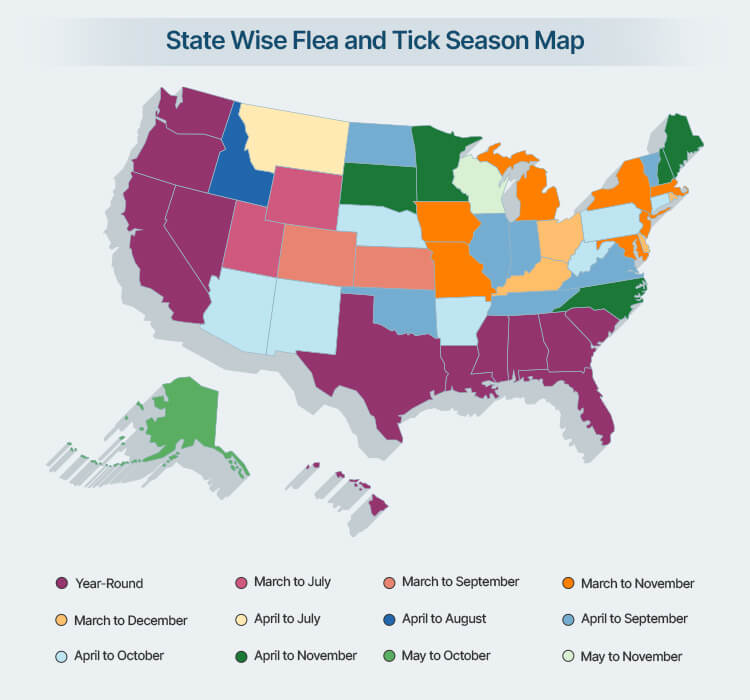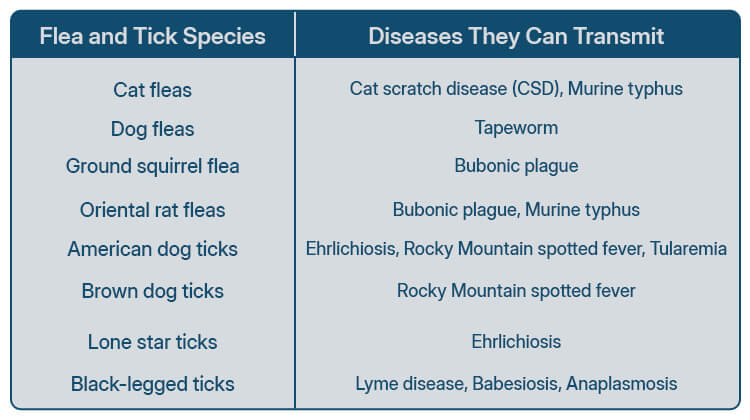Apr 08, 2025

As the days grow warmer and the sun shines brighter, our furry companions eagerly anticipate outdoor fun. However, this warm weather brings along the threat of increased activities of fleas and ticks, making it crucial for pet parents to be prepared. Although, the arrival of flea and tick season also varies depending on the climatic conditions of different regions.
In this blog, we'll provide a comprehensive guide to navigating flea and tick season 2025. From understanding the regional variations and identifying the signs of infestations, we've covered it all. We've also included some practical measures to protect your pets during flea and tick season in the US.
So, read till the end!
Essentially, flea and tick season is the period when fleas and ticks are most active. It is commonly associated with summer, as fleas and ticks need warm, humid conditions to thrive. The flea and tick season starts in spring and lasts for most of the fall, so it typically ranges between March and September.
However, the temperature and climate conditions are not the same throughout the United States. This difference in the weather impacts the arrival of this season in different states. Let's understand the flea and tick season in the USA with the help of a map.
There are states in the US where the terror of fleas and ticks looms over pets throughout the year. On the other hand, in some regions, the flea and tick prevalence peaks for a few months.
The following map will give you a better insight into the flea and tick season in your state:

|
Months |
States |
| Year-Round |
Alabama, California, Florida, Georgia, Hawaii, Louisiana, Mississippi, Nevada, Oregon, Pennsylvania, New York, South Carolina, Texas, Washington` |
| March to July |
Utah, Wyoming |
| March to September |
Colorado, Kansas |
| March to November |
Iowa, Maryland, Massachusetts, Michigan, Missouri, New Jersey, New York |
| March to December |
Delaware, Kentucky, Ohio, Rhode Island |
| April to July |
Montana |
| April to August |
Idaho |
| April to September |
Illinois, Indiana, North Dakota, Oklahoma, Tennessee, Vermont, Virginia |
| April to October |
Arizona, New Mexico, Nebraska, Arkansas, West Virginia, Pennsylvania, Connecticut, |
| April to November |
South Dakota, Minnesota, Maine, New Hampshire, North Carolina |
| May to October |
Alaska |
| May to November |
Wisconsin |
Now that you are aware of the flea and tick season in different states, let's look at the types of fleas and ticks that are most active in the season.
The most common flea and tick species you can encounter in the United States are:

The prevalence of fleas and ticks also varies as per the weather conditions of a particular region.
Regions with humid conditions, such as Pennsylvania, New York, and Florida, are impacted by fleas and ticks throughout the year. These states are inhibited by fleas, American dog ticks, brown dog ticks, lone star ticks, and black-legged ticks.
On the other hand, states that have less humid climates, such as Arizona, Idaho, Utah, Wyoming, Montana, etc., experience a shorter flea and tick season.
So, with a little research, you can learn about which species of fleas and ticks are common in your area.
These are the common symptoms of flea and tick infestations. Having this knowledge will help you identify the problem promptly and will assist your pet better.
These are some of the practical measures you can take to be better prepared for the flea and tick season:
This marks the end of our guide to preparing for the flea and tick season of 2025. We hope you now understand the arrival of this season in your state and are equipped to navigate through it. Implement the preventive measures discussed to ensure your pet enjoys a parasite-free summer! Good luck.
Mar 07, 2025